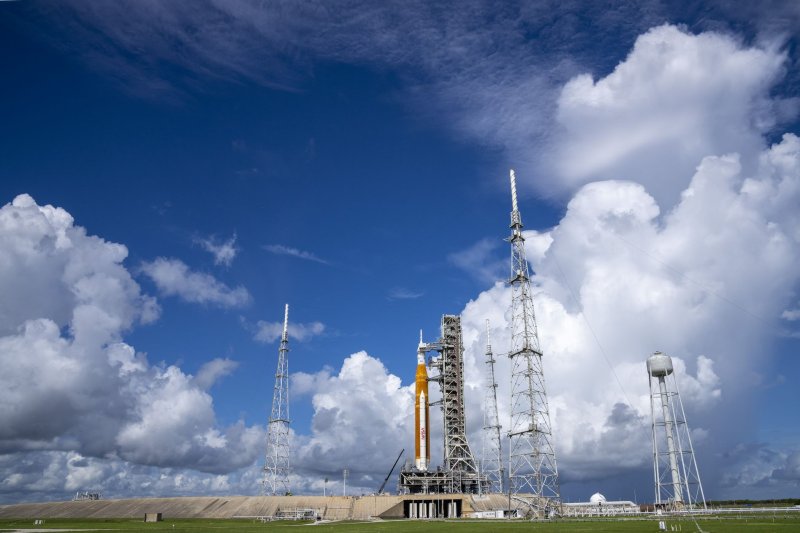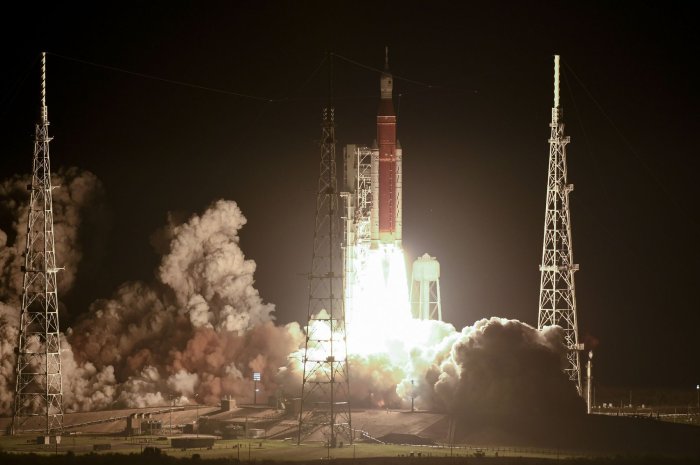1 of 5 | Artemis 1 sits on the launchpad at the Kennedy Space Center in Florida on Thursday, ahead of NASA's SLS rocket and Orion capsule scheduled lift off on Monday. Photo by Pat Benic/UPI |
License Photo
Aug. 26 (UPI) -- When NASA's Artemis I mission lifts off from the Kennedy Space Center in Florida on Monday, it will mark a major step forward for the space agency that will have been 12 years in the making.
The uncrewed test flight is the first for NASA's Space Launch System, which is paired with the Orion capsule, to ensure it can eventually deliver astronauts safely back to Earth.
The launch is the first step of a larger push to get American astronauts back on the surface of the moon.
"This first launch is another step on the blueprint on our sustainable exploration of the solar system and we are so proud to be the leader with NASA," NASA Associate Administrator, Exploration Systems Jim Free said Friday during a briefing.
"Artemis I is that first step down this path when we talk about sustained exploration on the lunar surface. This is our exploration system. I hope that everyone takes some pride nationally for what we've been able to do and where we are today."
That pride and first step seemed light years away more than a decade ago, agency officials have said.
Space shuttle program canceled
The final flights of NASA's Space Shuttle program were canceled in 2011 after 14 astronauts perished in two accidents.
The announcement came on the heels of then-President Barack Obama announcing an end to the agency's moon program amid calls for shifting manned launches to private industry. That meant a premature end to NASA's Constellation Program, which was meant to succeed the shuttles.
"We have come a long way," Holly Ridings, Deputy Director of NASA's Gateway Program, told UPI in a phone interview from the Johnson Space Center in Houston.
"One of the opportunities I had with my previous job was to do a lot of work in those 12 years as we transitioned to where we are today with Artemis," she said.
Ridings' Lunar Gateway Program aims to establish a space station orbiting the moon that will serve future lunar missions and is on schedule for launch by SpaceX in May 2024.
Monday's uncrewed Artemis I test flight is a step in that direction, the first in a series of missions ahead of a planned return to the lunar surface as early as 2025.
"We've got the vehicle out on the launch pad, we've got contracts for a lander. We have many elements for our Gateway space station that are in production that will be launched here in several years to have our permanent presence around the moon. My perspective on those 12 years is all a positive trajectory," Ridings said.
The Artemis II test flight will be the first with a crew aboard and will orbit the moon, before the Artemis III mission eventually touches down on the lunar surface.
"We created what we have today, Artemis I, SLS and Orion, out on the launchpad ready to go, and even beyond that, the entire Artemis enterprise. The process to me was one of resilience in a way that we always use," said Ridings, the first woman to hold the title of chief flight director at NASA.
"We have ideas, we learn from them and we take the next step in order to be successful. So I feel that was a stepping stone to where we are today."
Constellation transitions to SLS
That stepping stone, particularly the SLS rocket, was forged out of the sudden Constellation cancellation.
More than a decade later, NASA is taking a leap forward in what Free called a "hardware rich program," something that's not always the case for the space agency -- Orion capsules for future missions are already nearing completion.
Making all the systems come together and work in harmony is always the most difficult aspect, Ridings said.
"When you develop new spaceflight hardware, you have a lot of technical obstacles. You have to get your command and control system to work together, your communication system, your power system," she said.
"So the interfaces are the important part. If you think about SLS, you've got a first stage, you've got a second stage, you've got Orion, you've the Launch Abort System sitting up on top of it. So the interfaces are where you really have to look to make sure you've got it all working correctly."
"Going forward you add in your lander and docking and Gateway space station and all those elements, and then descend down to the surface and then ascend back up. So to me it should always be focused on those transition points between the different spacecraft," Ridings said.
She and the rest of NASA will be paying close attention on Monday, when the SLS rocket fires for the first time from the space center's historic Launch Complex 39B.
The mission itself will last 42 days, 3 hours and 20 minutes, and cover 1.3 million miles, reaching a speed of 24,500 mph during re-entry.
The Orion capsule is scheduled to splashdown on Oct. 10.
"If you have been around spaceflight, and certainly human spaceflight for any length of time, you know launch day is always a mix of excitement and nerves. I think I'll be more excited than anything," said Ridings.
The Space Launch System (SLS) rocket carrying an Orion spacecraft lifts off on the maiden flight of NASA's Artemis Program from Complex 39-B at the Kennedy Space Center on November 16, 2022. Photo by Joe Marino/UPI |
License Photo
















